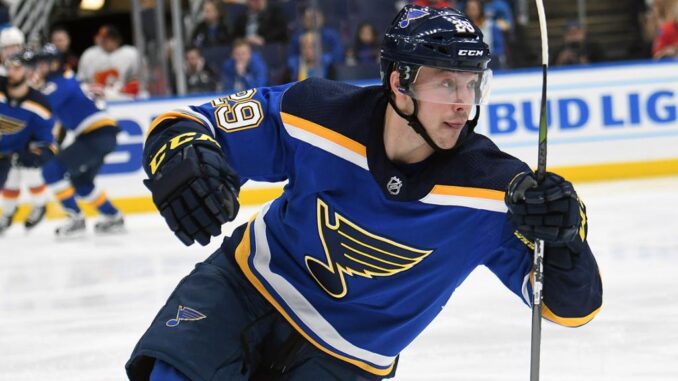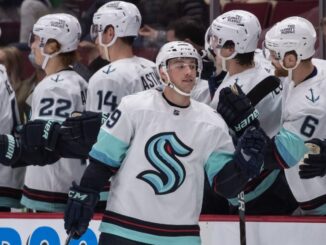
The Seattle Kraken were able to amass a boatload of auspicious talents during the expansion draft process, one of which was the St. Louis Blues’ Vince Dunn. He was chosen as Seattle’s selection from the Blues as the young blueliner found himself wedged behind established veterans on the Blues’ depth chart. The expanded opportunity for Dunn to accrue more ice-time on the power play and with the Kraken’s skilled forwards sets him up for a big breakout season.
The Writing Was on the Wall
Despite Dunn averaging the most ice time of his Blues’ tenure, the fourth-year defenseman only ranked 5th in all situations among all St. Louis defencemen and missed out on the playoffs entirely through injury, with Dunn last having played a game on April 24th.
Truthfully, the Blues made their choice well in advance of the expansion draft. Following the departure of former captain Alex Pietrangelo, St. Louis nabbed defenseman Torey Krug from the Boston Bruins to fill the gaping hole on their blueline. This addition was made only months after the Blues acquired Justin Faulk from the Carolina Hurricanes and promptly signed him to a seven-year, $45.5 million extension.
For those counting at home, that’s two (2) defensemen who would slot in ahead of Dunn at even-strength and special teams, limiting the amount of crucial development time available to the Mississauga, Ontario native.
Although the Blues have committed extensive term to both newcomers, the moves are slightly puzzling when Dunn could offer similar offensive production at a much cheaper price point. In any case, the Kraken were likely salivating once they saw such a promising talent exposed in the expansion draft.
Efficient Offensive Production
With a slight uptick in playing time came the most productive scoring pace of Dunn’s young career. The 20 points that he posted in 43 games this season represented a welcome step forward, and his even-strength points per 60 minutes ranked 84th among all NHL defensemen, and evidence that Dunn is bursting with more untapped potential.
Further, Dunn was one of the Blues’ most adept defenders in completing clean zone exits with possession, generating forward momentum on breakouts and chances off of zone entries. In fact, his results grade out as above average compared to the league average defender, and he actually outperformed his more heralded teammate in Krug.
Dunn demonstrated an eagerness for joining the rush out of defense, leading the Blues in individual scoring chances per 60 minutes, demonstrating his keen offensive awareness and unflappable composure in dangerous scoring areas.
Despite the Blues’ hesitation to fully unshackle him at even strength, Dunn featured heavily on the man-advantage this season as only Krug amassed more minutes on St. Louis’ power play units. What was surprising to note was that Dunn was arguably more efficient in his deployment, with his 5.83 points per 60 minutes (12th in the NHL among defensemen who played at least 50 minutes on the power play) ranking higher than his teammate, who finished in 20th.
Troubling Defensive Results
As I’ve been praising his offensive skills, it is only fair to note his defensive flaws. His on-ice rates of shot- and expected goals-share are well below 50% and are concerning when you consider he hasn’t been given the most difficult minutes. Dunn is a minor liability when it comes to his zone entry defense, as he allowed nearly 4 entries with chances against per 60 minutes this past season, the 2nd worst rate on the Blues blueline.
However, his partnership with Robert Bortuzzo was surprisingly effective, ranking 4th among all defensive pairs with 100 minutes played in expected goals against per 60 minutes. This suggests that pairing Dunn with a steady partner would allow him to thrive in that he would be freer to play to his strengths while ensuring the team is not conceding chances when he is on the ice.
The Verdict
Perhaps I’m too hard on the Blues, who may ultimately recognize Dunn’s potential but may not have the available ice time to play him as much as is merited by his early results.
It is an indictment of the mismanagement demonstrated by NHL executives in that aging defensemen moving out of their prime are awarded hefty contracts in favor of trusting burgeoning prospects who come in at a much lower cost, even if they have yet to grasp the art of defending when facing tougher competition fully.
However, St. Louis’ myopic evaluation could ultimately be Seattle’s gain, and don’t be surprised to see Dunn break out next season in an expanded role.
Data courtesy of Corey Sznajder, Evolving Hockey, Hockey Reference, and Natural Stat Trick.
Cap information courtesy of CapFriendly.




